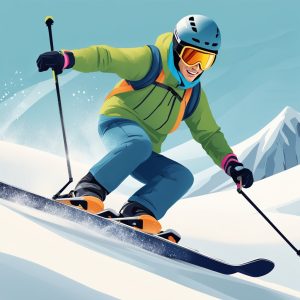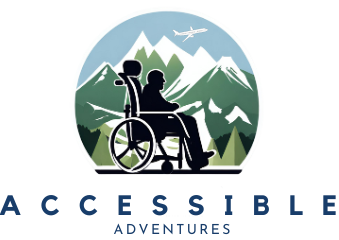Handicap Snow Skiing: Tips and Resources for Adaptive Skiing

If you have a disability, you might think that skiing is out of the question. However, with adaptive skiing, you can hit the slopes just like anyone else.
Adaptive skiing is a type of skiing designed for people with disabilities, and it’s a great way to get outside, enjoy the winter weather, and have fun.
Adaptive skiing is a growing sport that provides people with disabilities the opportunity to experience the thrill of skiing. With the right equipment and instruction, adaptive skiing can be accessible to anyone, regardless of their disability.
Adaptive skiing programs are available at many ski resorts, and they offer a variety of equipment and instruction to help you get started.
Whether you’re a beginner or an experienced skier, adaptive skiing can be a great way to get outside, stay active, and enjoy the winter season.
Key Takeaways
- Adaptive skiing is a type of skiing designed for people with disabilities.
- Adaptive skiing programs are available at many ski resorts and offer a variety of equipment and instruction to help you get started.
- Adaptive skiing is a great way to get outside, stay active, and enjoy the winter season.
Understanding Adaptive Skiing
If you have a disability, you may think that skiing is not an option. However, with adaptive skiing, skiing is possible for almost anyone.
Adaptive skiing uses specialized equipment and training to allow people with disabilities to experience the benefits of skiing.
In this section, we will cover the types of adaptive skiing, adaptive equipment overview, and skiing with different disabilities.
Types of Adaptive Skiing
There are several types of adaptive skiing, including sit-ski, bi-ski, and mono-ski.
A sit-ski is a chair on skis that allows the skier to sit down while skiing. Meanwhile, a bi-ski is a chair with two skis that allows the skier to sit down while skiing. Lastly, a mono-ski is a single ski with a seat on top that allows the skier to sit down while skiing.
Adaptive Equipment Overview
Adaptive equipment refers to the specialized equipment used in adaptive skiing. Some examples of adaptive equipment include outriggers and tethers.
Outriggers are short skis or poles with small skis on the bottom that are used for balance and stability. Meanwhile, tethers are ropes or straps that are used to help control the speed and direction of the skier.
Skiing with Different Disabilities
Adaptive skiing is possible for people with a wide range of disabilities, including para, amputation, visual impairment, cerebral palsy, spinal cord injuries, and multiple sclerosis.
For example, a sit-ski is a great option for people with spinal cord injuries, while a bi-ski is a great option for people with cerebral palsy.
Getting Started with Adaptive Skiing
If you have a disability and want to try skiing, adaptive skiing can be an excellent option. Adaptive skiing is a modified version of skiing that allows people with disabilities to enjoy the sport. Here are some tips to help you get started with adaptive skiing.
Choosing the Right Program
When choosing an adaptive ski program, it is important to find one that is right for you.
Some programs specialize in teaching specific types of disabilities, while others are more general.
It is also important to find a program that has experienced instructors who are trained to work with people with disabilities.
The National Sports Center for the Disabled and Disabled Sports USA are two organizations that offer adaptive ski programs. These programs are designed to help people with disabilities learn how to ski and snowboard in a safe and supportive environment.
Finding Qualified Instructors
Qualified instructors are essential to learning how to ski.
When looking for an adaptive ski program, make sure to ask about the qualifications of the instructors.
Look for instructors who are certified by the Professional Ski Instructors of America (PSIA) or the American Association of Snowboard Instructors (AASI).
Ski Resorts with Adaptive Programs
Many ski resorts now offer adaptive ski programs, making it easier than ever to learn how to ski.
Winter Park, Vail, Whistler, and Killington are just a few of the ski resorts that offer adaptive programs. These programs often include specialized equipment and trained instructors to help people with disabilities learn how to ski. The Vail program also has a blind skier program.
Equipment and Accessibility
If you have a disability, you might think that snow skiing is not an option for you. However, with specialized skiing equipment and accessibility features at ski resorts, you can enjoy this exciting sport just like anyone else.
Specialized Skiing Equipment
There are various types of specialized skiing equipment designed for people with disabilities.
Sit skis, mono-skis, and bi-skis are some of the most common examples.
Sit skis are bucket-style seats with a single ski underneath that is held directly on the snow. Mono-skis are similar to sit skis but have a more streamlined design. Meanwhile, bi-skis are two skis that are connected together and have a seat on top for the skier to sit in.
In addition to these types of skis, there are other pieces of equipment that can make skiing more accessible for people with disabilities.
Outriggers are poles with small skis on the bottom that can help with balance and stability. Meanwhile, tethers are straps that can be used to connect a skier to their instructor or guide.
Accessibility Features at Ski Resorts
Many ski resorts have adapted equipment and programs for people with disabilities.
Some resorts offer adaptive skiing programs where instructors are trained to work with skiers with disabilities and have adapted equipment available. Accessible parking spaces and terrain are also often available.
It’s important to do your research and find a ski resort that meets your needs. Look for a resort that has accessible parking, terrain, and equipment. Some resorts may require advanced notice to ensure that they have the right equipment available for you.
Beyond the Basics
If you have mastered the basics of adaptive skiing, you may be ready to try some more advanced techniques and training. Here are some tips to help you take your skills to the next level.
Advanced Techniques and Training
One way to improve your skiing is to work on your balance and control.
Advanced skiers with physical disabilities may benefit from specialized training programs that focus on developing strength, endurance, and agility.
These programs can help you improve your balance, reduce your risk of injury, and increase your confidence on the slopes.
Another way to improve your skiing is to experiment with different types of equipment.
For example, some skiers with physical disabilities may prefer to use a sit-ski or a mono-ski rather than a traditional two-skied setup.
Blind skiers may use a guide or a tether to help them navigate the mountain. Meanwhile, hearing-impaired skiers may benefit from using a helmet with built-in speakers that can transmit audio signals.
Competitive Adaptive Skiing
If you’re looking for a new challenge, you may want to consider competitive adaptive skiing.
The Paralympic Alpine Skiing events are open to skiers with physical disabilities, and there are also a number of other competitions and championships held around the world.
The Disabled World Alpine Skiing Championships are a popular event for disabled skiers of all levels.
To compete in adaptive skiing, you’ll need to be in top physical condition and have excellent skiing skills.
You’ll also need to be familiar with the rules and regulations of the sport, as well as the different categories and classifications.
Training with a coach or a team can help you prepare for competition and improve your performance.
Frequently Asked Questions
What types of adaptive skiing equipment are available for disabled skiers?
There are several types of adaptive skiing equipment available for disabled skiers. These include sit skis, mono skis, bi-skis, and outriggers.
Sit skis are designed for people with lower limb disabilities and allow them to sit while skiing. Meanwhile, mono skis are designed for people with spinal cord injuries and allow them to sit in a bucket seat while skiing.
Bi-skis are designed for people with cerebral palsy and other mobility impairments and allow them to sit and balance while skiing. Lastly, outriggers are crutches with skis on the bottom and are used by skiers with upper limb disabilities to help with balance and turning.
How does one get started with handicap snow skiing training?
Getting started with handicap snow skiing training involves finding a program that offers adaptive skiing lessons.
Many ski resorts and organizations offer adaptive skiing programs that provide specialized equipment and trained instructors to help disabled individuals learn how to ski.
It is important to communicate your needs and goals with the program coordinators so they can provide you with the appropriate equipment and instruction.
Are there specific snow skiing programs for individuals with cerebral palsy?
Yes, there are specific snow skiing programs for individuals with cerebral palsy.
These programs often use bi-skis, which provide additional support and stability for skiers with mobility impairments.
The National Sports Center for the Disabled in Winter Park, Colorado, offers adaptive skiing programs specifically for individuals with cerebral palsy.
What are the costs associated with handicap snow skiing?
The costs associated with handicap snow skiing vary depending on the program and equipment used.
Some programs offer scholarships or financial assistance for individuals with disabilities.
It is important to research different programs and inquire about costs and financial assistance options.
How can disabled people participate in snow skiing competitions, such as the Paralympics?
Disabled individuals can participate in snow skiing competitions, such as the Paralympics, by training with adaptive skiing programs and competing in qualifying events.
The Paralympics has specific eligibility criteria for athletes with disabilities, which can be found on their website.
It is important to work with a qualified coach and follow proper training and competition guidelines.
Where can I find handicap snow skiing programs near my location?
You can find handicap snow skiing programs near your location by searching online or contacting your local ski resort or disability organization.
The National Sports Center for the Disabled and Disabled Sports USA both offer adaptive skiing programs and have information on programs throughout the United States.
